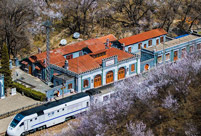


(File photo)
Senior management of the China Railway Corporation has said that raising the speed of China's high-speed rail is an economic problem rather than a technological one. According to a report in China Business Journal, in order to raise the average speed of China's high-speed rail from the current 300 kilometers per hour to 350 kilometers per hour, operational costs would have to increase by about one-third.
In recent years, calls to increase the speed of China's high-speed rail have been growing stronger and stronger. On June 3, President Xi Jinping asked railway experts at the exhibition on China's science and technology achievements during the 12th Five-Year Plan: Is China’s high-speed rail currently able to regain the speed of 350 kilometers per hour?
China’s high-speed rail used to be faster, but the maximum speed was decreased as of July 1, 2011. Except for the Beijing–Tianjin route, high-speed routes with a previous maximum speed of 350 kilometers per hour all dropped to 300, and the question of returning to 350 has not been raised again until now.
He Huawu, Chief Engineer of the China Railway Corporation, told the reporter from China Business Journal that it is technically feasible for trains to regain the higher speed, but the decision has not yet been made due to financial concerns. "Higher speed will cause greater wheel and rail wear, which means higher costs. If the ticket price and number of travelers stays the same, it would not be economically feasible," He said.
At an interview during the Two Sessions meetings,Sheng Guangzu, General Manager of the China Railway Corporation, said that raising the speed to 350 kilometers per hour would make operational costs one-third higher, mainly due to the increase in power, greater wear on parts and maintenance costs.
 French girl ties the knot with Chinese boy
French girl ties the knot with Chinese boy Beijing Style: Hot pants
Beijing Style: Hot pants Century-old station sees railyway evolution
Century-old station sees railyway evolution Enthusiasts perform Kung Fu at Wudang Mountain
Enthusiasts perform Kung Fu at Wudang Mountain Students take stylish bikini graduations photos
Students take stylish bikini graduations photos Charming dancing students pose for graduation photos
Charming dancing students pose for graduation photos China opens its first combined transport service to Nepal
China opens its first combined transport service to Nepal Naked models transformed into landscapes, birds and even DRAGONS by body painting artist
Naked models transformed into landscapes, birds and even DRAGONS by body painting artist China's first interactive robot looks like a beauty
China's first interactive robot looks like a beauty Top 20 hottest women in the world in 2014
Top 20 hottest women in the world in 2014 Top 10 hardest languages to learn
Top 10 hardest languages to learn 10 Chinese female stars with most beautiful faces
10 Chinese female stars with most beautiful faces China’s Top 10 Unique Bridges, Highways and Roads
China’s Top 10 Unique Bridges, Highways and Roads Mainland market power sways Lancôme
Mainland market power sways Lancôme China encourages commercialization of museums
China encourages commercialization of museums Beijing parents protest against ‘favorable treatment’ of ethnic students in gaokao
Beijing parents protest against ‘favorable treatment’ of ethnic students in gaokao  Young Chinese are finding a new way of paying tribute to their favorite stars charity
Young Chinese are finding a new way of paying tribute to their favorite stars charityDay|Week